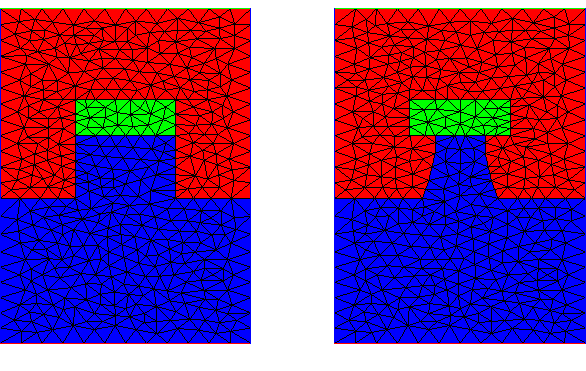
|
|
|
|
[Contents] | [Index] |
Collaborator: G. Bruckner , J. Elschner , A. Rathsfeld , G. Schmidt
Cooperation with: B. Kleemann (Carl Zeiss Oberkochen), R. Güther (Ferdinand-Braun-Institut für Höchstfrequenztechnik Berlin), G. Bao (Michigan State University, East Lansing, USA), J. Cheng (Fudan University, Shanghai, China), M. Yamamoto (University of Tokyo, Japan)
Supported by: BMBF: ``Modellierung und Optimierung mikrooptischer Oberflächenstrukturen'' (Modeling and optimization of microoptic surface structures - 03ELM3B5), DFG: ``Scientific cooperation with Japan: Inverse problems in electromagnetics''
Description:
1 Accurate FEM simulation of diffraction by polygonal gratings (J. Elschner, A. Rathsfeld, G. Schmidt).
As is well known, the diffraction of electromagnetic plane waves by optical gratings (i.e. devices which are independent in one direction, say, in the direction of the x3 coordinate, and the cross section of which in the x1-x2 plane is periodic in another direction, say, in that of the x1 coordinate) can be reduced to various boundary value problems for the Helmholtz equation. From their solution all interesting features, including the reflected/transmitted energy, the reflection/transmission efficiencies (percentage of the light reflected/transmitted in a finite number of predetermined directions), and of course the near field behavior can be derived.
The main difficulty in the FEM approach is to deal with large wave numbers requiring small step sizes and, therewith, the solution of huge systems of equations. However, the technological progress allows to produce smaller devices, and the FEM solution of the resulting boundary value problems with moderate wave numbers becomes more and more attractive. Nevertheless, there is still a need to solve problems with larger wave numbers, e.g., problems for coated echelle gratings with ``larger'' periods. Therefore, the old package DiPoG contains a generalized FEM with reduced so-called pollution error. Unfortunately, the basic idea of this method relies on uniform partitions. We started to consider an alternative generalized FEM on triangular grids. This uses a new basis of trial functions which are locally the approximate solution to the Helmholtz equation. The first results are promising. However, the parameters still need to be adjusted and the code must be optimized. In other words, the work on the generalized FEM will be continued.
Finally, for our cooperation partner in Oberkochen, we rendered an expert opinion on several aspects of the integral equation method applied to diffraction gratings.
2 Reconstruction of grating profiles (G. Bruckner, J. Elschner, G. Schmidt).
The problem of recovering a periodic structure from illuminating the structure by incident plane waves is of great practical importance in modern diffractive optics, e.g., in quality control and optimal design of diffractive elements (see [1]). The efficient numerical solution of inverse problems of this type is challenging due to the fact that they are both nonlinear and severely ill-posed in general. So far we considered scattering of time-harmonic plane electromagnetic waves in the TE (transverse electric) mode by a two-dimensional perfectly conducting periodic structure, which is modelled by the Dirichlet problem for the Helmholtz equation. The results will be extended to the inverse TE and TM transmission problems for diffraction gratings in the near future.
Let the profile of the diffraction grating be given by the graph
![]() of a
of a ![]() -periodic Lipschitz function, and suppose that a plane wave given
by
-periodic Lipschitz function, and suppose that a plane wave given
by ![]() is incident from the top. Here the wave number k is a
positive constant,
is incident from the top. Here the wave number k is a
positive constant,
![]() ,
,![]() , and
, and ![]() is the
incident angle. In the
inverse or
profile reconstruction problem,
one tries to determine
the profile function f from measurements of the scattered field,
e.g., from the Rayleigh coefficients of the propagating modes
(possibly for several wave numbers and/or incident angles).
is the
incident angle. In the
inverse or
profile reconstruction problem,
one tries to determine
the profile function f from measurements of the scattered field,
e.g., from the Rayleigh coefficients of the propagating modes
(possibly for several wave numbers and/or incident angles).
The conditional (global) stability of this problem for smooth profile curves and small wave numbers was proved in [3]. The method is based on a Carleman estimate for the Laplace operator and originates from the inverse problem of determining an unknown part of the boundary modelled by the Laplace equation. The consequences for Tikhonov regularized reconstruction procedures are studied in [4], where a logarithmic convergence rate is obtained. Local stability estimates of Lipschitz type for nonsmooth grating profiles were derived in [6], using a new approach based on the material derivative method.
In [4], [7], we studied the performance and convergence of an effective inverse method, which is based on an approach by Kirsch and Kress (for acoustic obstacle scattering; see [2]) and avoids the solution of the direct scattering problem. In this method, the inverse problem is decomposed into the severely ill-posed linear problem of reconstructing the scattered wave from its far-field pattern, and into the well-posed nonlinear problem of determining the unknown profile curve as the location of the zeros of the total field. The convergence analysis covers the practically important case of nonsmooth grating profiles and is based on new perturbation and stability results for the direct problem, see [7].
The discretization of the resulting optimization problem then leads to a nonlinear least-squares problem which is solved iteratively by the Levenberg-Marquardt algorithm. In the case of Fourier gratings our method proved to be rather efficient if the grating grooves are not too deep. First numerical results are also obtained for piecewise linear profile curves.
References:
|
|
|
[Contents] | [Index] |